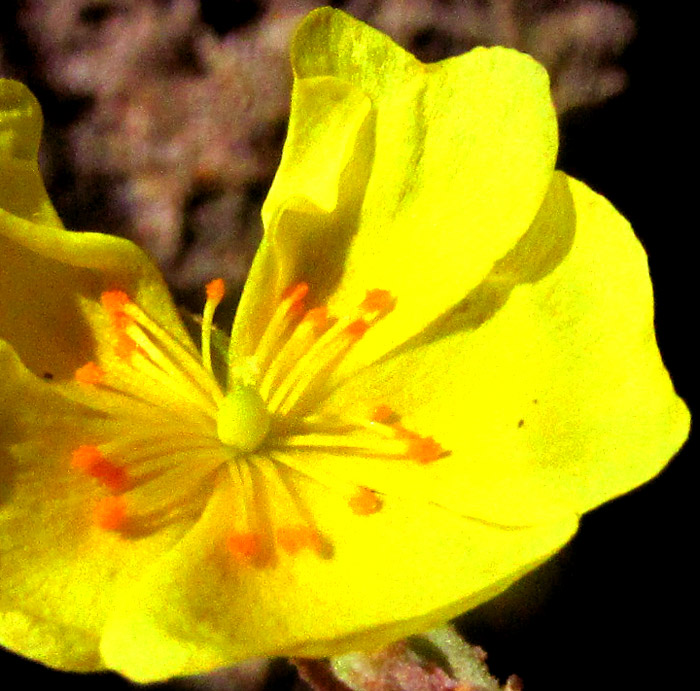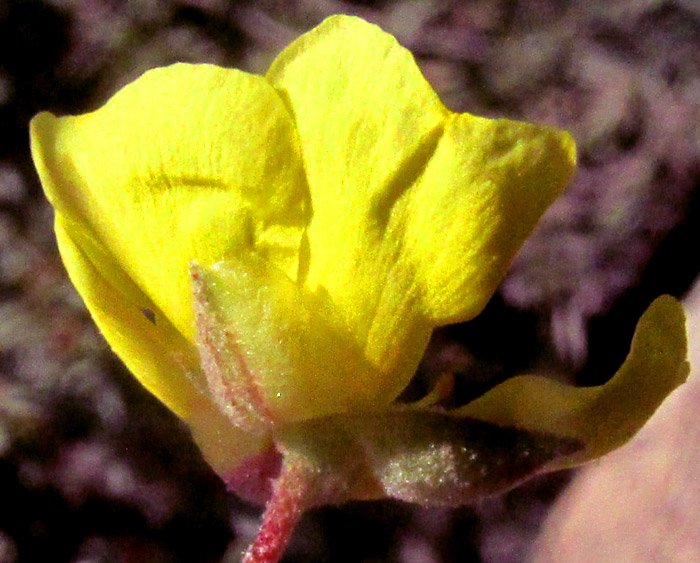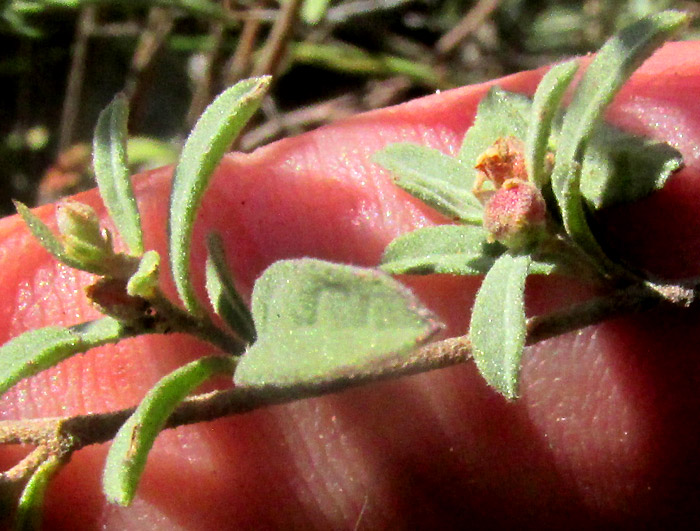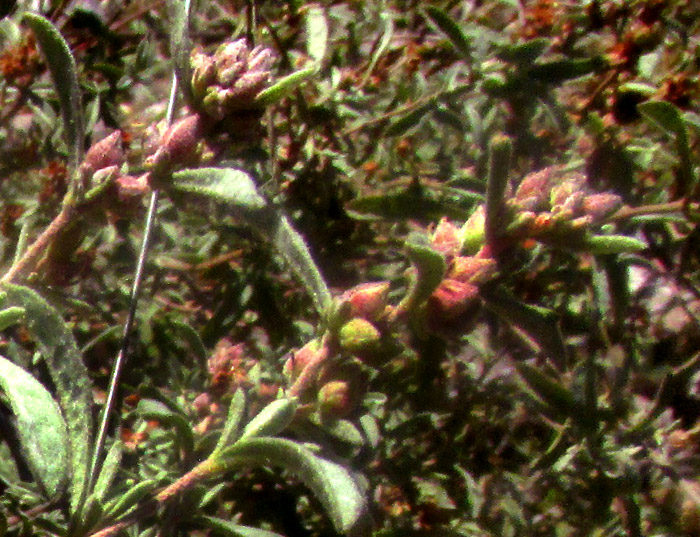Excerpts from Jim Conrad's
Naturalist Newsletter
Entry dated November 7, 2023, from notes taken near Cascadas de La Piedad waterfall 3kms NW of the community of San Pablo, municipality of Almeaco de Bonfil; bedrock of thick layers of compacted volcanic ash, or tuff; N20.1024°, W100.0019°, elevation 2360 meters (7750ft); extreme southern Querétaro state, MÉXICO
CLUSTERED FROSTWEED

In a grassy open area on a slope mostly forested with oaks, several of the above bushy herbs were present, though only the small blossom shown above was apparent.

Something has distorted the above flower's two top petals; there are five of them, all normally with the same shape. About 23 stamens are present. The ovary is superior, with a short, thick style topped with a somewhat three-lobed stigma.

Above, only three large sepals easily are seen. However, the literature says that five sepals are present in two series. The shorter outer ones are very narrow, while the inner sepals are egg-shaped, or ovate, with each consisting of a fleshy, reddish or yellowish zone, along one side of which a membranous, or scarious area arises. In the above picture only the three outer ones are clearly distinguishable. This is a a very unusual combination of calyx features.

Vegetative parts were so densely covered with branched hairs that the whole plant presented an ashy appearance.

Closed flowers covered with pink sepals clustered at branch tips. Later I'd realize that these were more than immature flower buds; they were flowers which never open, thus are not pollinated by insects. Being self-pollinated, their seeds carry less evolution-enabling genetic diversity than seeds from cross-pollinated flowers. Such flowers are said to be cleistogamous. There's more information on Wikipedia's Cleistogamy page.
Though the flowers at first look "normal," the combination of features was unusual. The online identification key for New World plant families at KeyServer.LucidCentral.org currently starts with 319 potential families. Keying in flowers with five sepals forming a bilaterally symmetrical calyx, five separate petals, 23 stamens and a superior ovary with one style, and already you've eliminated the possibility of having a member of all but seven possible families. Add that the leaves bear branched but not T-shaped hairs, and you're down to three families. Of those three families, only one produces cleistogamous flowers, and that's the Rock-rose Family, the Cistaceae.
The Rock-rose Family currently comprises only nine genera with up to 200 species. However, among gardeners, some of its species are well known ornamentals, called rock-roses. Unfortunately, the rock-rose name is used for numerous species in at least seven genera. Possibly the best known rock-rose is a succulent, ground-hugging Portulaca, not belonging to the Rock-rose Family.
In our part of upland central Mexico known as the Bajío Region, the 1992 treatment of the Cistaceae in the Flora del Bajío reports the presence of two Cistaceae genera: the genus Lechea, whose small flowers bear three petals, and; our five-petaled plant's genus, which the Flora calls Helianthemum. However, nowadays New World species formerly assigned to Helianthemum have been shifted to the genus Crocanthemum. Species of Crocantheum often are referred to as frostweeds, and are regarded as fire tolerant.
Among the eight Flora species of what now are considered the genus Crocanthemum, if your plant bears branched hairs, the leaves are much wider than 2mm (1/16th inch), the pedicels of cleistogamous flowers are very short or absent, and if few to no open blossoms are present, you have CROCANTHEMUM GLOMERATUM, in English often known as the Clustered Frostweed.
Crocanthemum glomeratum occurs in dry, montane, oak and pine woodlands, grassy areas and even disturbed areas from the Chisos Mountains of western Texas south through Mexico's uplands into Costa Rica. It's described as the most widely distributed and commonly occurring Crocanthemum species in our area. The Flora del Bajío mentions that open flowers are mainly produced during the dry season, October to May, while cleistogamous flowers can occur year round.The study by Martha Cedano-Maldonado and others entitled "Wixaritari or Huichol Ethnobotany of the Southern Sierra Madre Occidental in Mexico," included in the 2023 book Ethnobotany of the Mountain Regions of Mexico, edited by Alejandro Casas and José Juan Blancas Vázquez, reports that in the Wixaritari or Huichol part of the southern Western Sierra Madres, Crocanthemum globeratum is used to treat stomach-ache, and livestock feed on it. The 2022 doctoral dissertation by Mónica Lilian Pérez Ochoa entitled "Conocimiento local y compuestos bioactivos de plantas medicinales utilizadas en el tratamiento de desórdenes gastrointestinales: Estudios de caso en Oaxaca," reports that a decoction of Crocanthemum globeratum is used to treat both stomach ache and diarrhea.